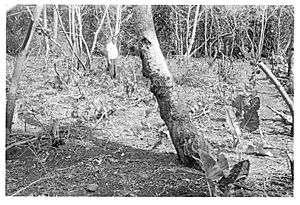Agriculture in Tonga facts for kids
The Agriculture of the Tongan Archipelago is mostly about growing yams, squash, and other root crops. Farming is a big part of Tonga's economy. It makes up about 16% to 30% of the country's total income (GDP). Also, 34% of all workers in Tonga are farmers, and about half of what Tonga sells to other countries comes from agriculture.
Since the 1980s, Tonga has started selling more farm products. These include vanilla, watermelons, sugar, and legumes. However, with more people living in Tonga, changes in the weather, and tough competition, Tonga sometimes finds it hard to keep up with what buyers want.
How Farming Changed in Tonga
Old Ways of Farming
In the past, people in Tonga used a farming method called "subsistence farming." This means they grew just enough food for themselves and their families. They also used a system called "shifting cultivation and fallowing." This involved growing crops in one area for a while, then letting the land rest for a few years.
Over time, this system led to a way of paying taxes. Farmers would give yams to the nobles and the king. Yams were seen as the most important crop. They were grown mainly for the rulers and for a special yearly feast called Inasi. Before people from Britain and Europe arrived, there were no markets in Tonga to buy and sell goods.
The Tongan calendar was based on the moon's cycle and when crops were planted. In fact, the Tongan words for "year" and "crop of yams" are the same: ta'u. This calendar had 13 months. It usually started around November 6 and ended in late October or early November.
Shifting Cultivation
Here's how shifting cultivation worked:
- First, a piece of land with plants on it would be cleared using a method called slash and burn. This means cutting down plants and burning them.
- Then, crops would be planted in that area.
- After harvesting, the land would be left to rest for two to four years. This resting period is called "fallowing."
The farming cycle usually began with yams, alocasia, and plantains. These crops would grow for eight or nine months, or even up to two or three years. After they were harvested, new crops would be planted. Next came sweet potatoes, which grew for four to six months. After that, xanthosoma was planted for ten to twelve months. Finally, the tough cassava plant would be grown for a year.
Modern Farming Today
After European people came to Tonga, the old way of subsistence farming changed. It was replaced by what is called "semi-permanent" or commercial farming. This means growing crops to sell them.
Even though it can be hard to move goods between Tonga's islands, and the country doesn't have the most advanced farm technology, Tonga is still a key producer of crops. It sells these crops to countries in East Asia and Oceania. For example, Tonga provides 60% of the watermelons that New Zealand buys from other countries. Since the mid-1980s, Tonga has also grown squash for Japan and South Korea. However, sometimes too much squash was grown (this is called overproduction), which made its value go down. Because of this, less squash is produced now.


